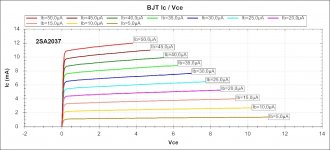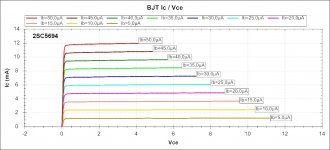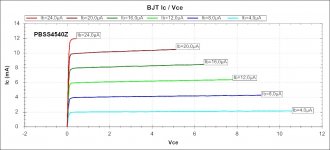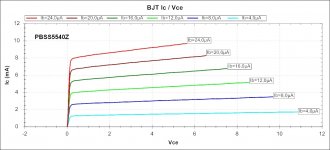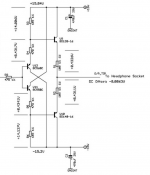They make many types, so does Zetex, also with high and linear Hfe.
Early voltage is high on the PNPs by default so they are quite symmetric.
Low VCEsat (BISS) transistors :: NXP Semiconductors
I have not tested them all but early experince is positive.
For more information you can send me 100.000,- € To my bank account in switzerland.....
Early voltage is high on the PNPs by default so they are quite symmetric.
Low VCEsat (BISS) transistors :: NXP Semiconductors
I have not tested them all but early experince is positive.
For more information you can send me 100.000,- € To my bank account in switzerland.....
Thanks for this.http://www.angelfire.com/sd/paulkemble/sound4.html
Here is the D.Self and the Lee.
I describe the history of my 1981 Wireless World "Lee" and some 21st century improvements in my Yahoo MicBuilders directory. There are red herrings in the Wireless World article as at one time, I was planning commercial production.
A version with a pair of Hitachi devices is within 1dB of Iono for a 5R source.
_________________
Which ones did you try?Low VCEsat (BISS) transistors :: NXP Semiconductors
I have not tested them all but early experince is positive.
Alas, these days, I'm a beach bum but I don't think even Mr. Marsh has 100.000,- € spare .. But I'm sure he will be pleased to measure some for you. 🙂
Myself, I am more interested in power amps of 200-300W size..... much harder... larger Volts and Amps, etc. BUt this place here is line level amps only. Not MM or MC.
They are not output devices for 200-300W amps, but excellent for line level circuits and headphone amps: Sanyo 2SA2037/2SC5694
Very reliable USA Ebay seller, < US$ 5 for 20 pcs (10 pcs each).
Low VCEsat (BISS) transistors :: NXP Semiconductors
I have not tested them all but early experince is positive.
Joachim, PBSS4540Z/5540Z, I am using them in SMD power supply regulators. Decent performers, very robust & reliable.
Last edited:
Yes, GasFets excell at RF.
I worked in a microwave lab too, so what ?
then move on the second and other sentences and read it also.
-RM
Last edited:
Alas, these days, I'm a beach bum but I don't think even Mr. Marsh has 100.000,- € spare .. But I'm sure he will be pleased to measure some for you. 🙂
yes, i do but I wouldnt for info I can learn from books and catalogs. Maybe for some insider trading info....
yes, I would be pleased to measure the noise and post it for all..... because it helps make the SIM models more accurate (and keeps the mfr honest).
THx-RNMarsh
Last edited:
They are not output devices for 200-300W amps, but excellent for line level circuits and headphone amps: Sanyo 2SA2037/2SC5694
Very reliable USA Ebay seller, < US$ 5 for 20 pcs (10 pcs each).
Joachim, PBSS4540Z/5540Z, I am using them in SMD power supply regulators. Decent performers, very robust & reliable.
Great -- some part numbers. I'll look for some and test them for noise and linearity.
I have a few weeks left.... anyone else favorite they are curious about?
Any favorite microwave strip-line packaged transistors tried and recommended?
Anything you/others have tried and were pleasantly surprised?
THx-RNMarsh
Last edited:
Yes, it was E A Faulkner was the guy who first published in 'Electronics Letters' in 1966 (I'm pretty sure). However, I did not get a patent from paralleling the devices, but the unusual topology that I used, that was push pull for distortion cancellation, but noise parallel for efficient low noise design.
Measured with Atlas DCAPro 75
Attachments
Last edited:
Early voltage of the 2sc5694 is especially high.
Whereas the pbss5540z is especially low/bad.
Why should the pbss4540z be quite a bit higher?
is one a PNP and the other a NPN?
Whereas the pbss5540z is especially low/bad.
Why should the pbss4540z be quite a bit higher?
is one a PNP and the other a NPN?
Noise measured -
dont mind me -- I found some other low noise transistors around here.....
3mA/15v. PNP --
100Hz/1KHz/10KHz/100KHz
4.5nV 1.1nV .9nV 1.0nV = 2SA970
4.2nV .35nV .5nV .3nV = 2SB737
THx-RNMarsh
dont mind me -- I found some other low noise transistors around here.....
3mA/15v. PNP --
100Hz/1KHz/10KHz/100KHz
4.5nV 1.1nV .9nV 1.0nV = 2SA970
4.2nV .35nV .5nV .3nV = 2SB737
THx-RNMarsh
Mr. Marsh, thank you again.
Still surprised by BC327/337 performance compared to low noise 2SA970.
@AndrewT
Yes, PBSS4540/5540 are NPN/PNP in SOT223 package. Early effect is more noticeable in PNP's. You should see some other transistor measurements, they are much worse. Ideal devices exists only in textbooks.
Still surprised by BC327/337 performance compared to low noise 2SA970.
@AndrewT
Yes, PBSS4540/5540 are NPN/PNP in SOT223 package. Early effect is more noticeable in PNP's. You should see some other transistor measurements, they are much worse. Ideal devices exists only in textbooks.
Thanks for these Mr. Marsh.3mA/15v. PNP --
100Hz/1KHz/10KHz/100KHz
4.5nV 1.1nV .9nV 1.0nV = 2SA970
4.2nV .35nV .5nV .3nV = 2SB737
Your 2sa970 measurements are slightly worse than my Jurassic ones (and the datasheet noise contours). BC327/337 would appear at least as good or better. An excellent substitute for 2sa970 & 2sc2240 which are also becoming Unobtainium
2sb737 confirms its reputation for rbb' at 2R or less 🙂
Thanks for these Mr. Marsh.
Your 2sa970 measurements are slightly worse than my Jurassic ones (and the datasheet noise contours). BC327/337 would appear at least as good or better. An excellent substitute for 2sa970 & 2sc2240 which are also becoming Unobtainium
2sb737 confirms its reputation for rbb' at 2R or less 🙂
Noise differences may partially be explained by different operating conditions (volts and amps). But the 2SA970 does not appear to be lower than a whole bunch of other transistors. But that 737 is a keeper. Think I'll stock up on more of those.
-RM
Last edited:
BC327/337 would appear at least as good or better.
So would the BC327/337 be a good substitute for the BC550/560?
If not, what are some good substitutes?
Mr. Marsh, the PNP 2sb737 is now Unobtainium. If you've found a source, guard it carefully.But that 737 is a keeper. Think I'll stock up on more of those.
Depends, as always, on the application.So would the BC327/337 be a good substitute for the BC550/560?
Much of this recent discussion is about LoZ Very Low Voltage Noise stuff. There's not a lot of stuff that requires this level of Low Noise.
There is a bigger general advantage at low Vce cos BC3x7 is more 'linear' at low Vce. keantoken is the authority on this.
Last edited:
kgrlee --- I just found a source and quickly bought 100 of them. 🙂 Just safe-keeping for the audiophile DIY community.
-RM
-RM
Last edited:
Depends, as always, on the application.
Much of this recent discussion is about LoZ Very Low Voltage Noise stuff. There's not a lot of stuff that requires this level of Low Noise.
There is a bigger general advantage at low Vce cos BC3x7 is more 'linear' at low Vce. keantoken is the authority on this.
Here's the application I had in mind:
Attachments
4.5nV 1.1nV .9nV 1.0nV = 2SA970
I believe that the same die as A970 is used in A1312 (sot23) and A1576 (sot323), both of which are readily available, at least in -Y and -GR beta selections, though -BL is a bit elusive. The corresponding NPNs are C2240, C3324 and C4117.
Last edited:
BC327/337 would appear at least as good or better. An excellent substitute for 2sa970 & 2sc2240 which are also becoming Unobtainium
BC327/337 have much lower Vceo at 45V vs. 120V for the A970/C2240. The former also have much higher Icmax. IIRC, the pinout also differs - CBE vs. BCE, so they're not direct substitutes.
I need to check this, but the beta at low currents probably holds up better in the A970/C2240 and its SMD equivalents.
The BC3x7 are an improvement on the BC5xx in the following circumstances:
1: Higher SOA, surge current up to 1A, high thermal capacity in the die.
2: Almost nonexistant quasi-saturation - no better known transistor for low-Vce low-power applications such as C-multipliers, giving PSRR up to over 70db (the BC5xx follows closely at 60db, I wonder if newer BISS transistors from NXP could be better?). This also makes them ideal for current mirrors where gain is lost through quasisaturation (BIG mistake to use high-voltage japanese transistors here).
3: Much lower noise due to small base resistance. This makes them an improvement for input stages in amplifiers, as well as current mirrors in LTPs.
The drawbacks are:
1: More capacitive and slower, will will have more distortion than the BC5xx when used with a high source impedance. Still very fast though.
2: Lower gain than the BC5xxC. Typically the BC3x7-40 has a gain of 400 while the BC5xxC has 500.
Either transistor will work well for this purpose. The BC3x7 will have lower noise but with lower input impedance. The BC5xx will be faster with higher input impedance, but higher noise.
1: Higher SOA, surge current up to 1A, high thermal capacity in the die.
2: Almost nonexistant quasi-saturation - no better known transistor for low-Vce low-power applications such as C-multipliers, giving PSRR up to over 70db (the BC5xx follows closely at 60db, I wonder if newer BISS transistors from NXP could be better?). This also makes them ideal for current mirrors where gain is lost through quasisaturation (BIG mistake to use high-voltage japanese transistors here).
3: Much lower noise due to small base resistance. This makes them an improvement for input stages in amplifiers, as well as current mirrors in LTPs.
The drawbacks are:
1: More capacitive and slower, will will have more distortion than the BC5xx when used with a high source impedance. Still very fast though.
2: Lower gain than the BC5xxC. Typically the BC3x7-40 has a gain of 400 while the BC5xxC has 500.
Here's the application I had in mind:
Either transistor will work well for this purpose. The BC3x7 will have lower noise but with lower input impedance. The BC5xx will be faster with higher input impedance, but higher noise.
- Home
- Source & Line
- Analog Line Level
- Discrete Opamp Open Design
